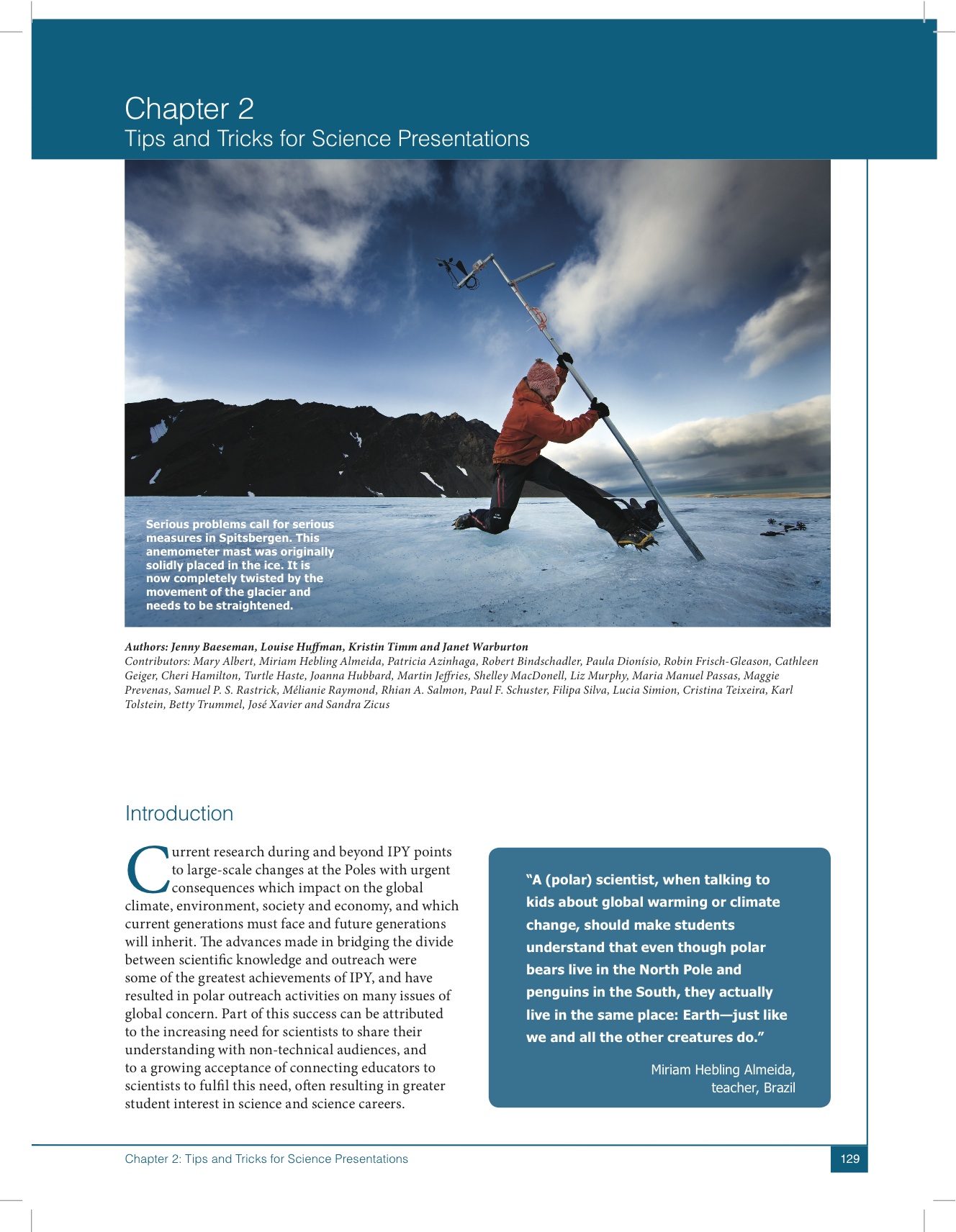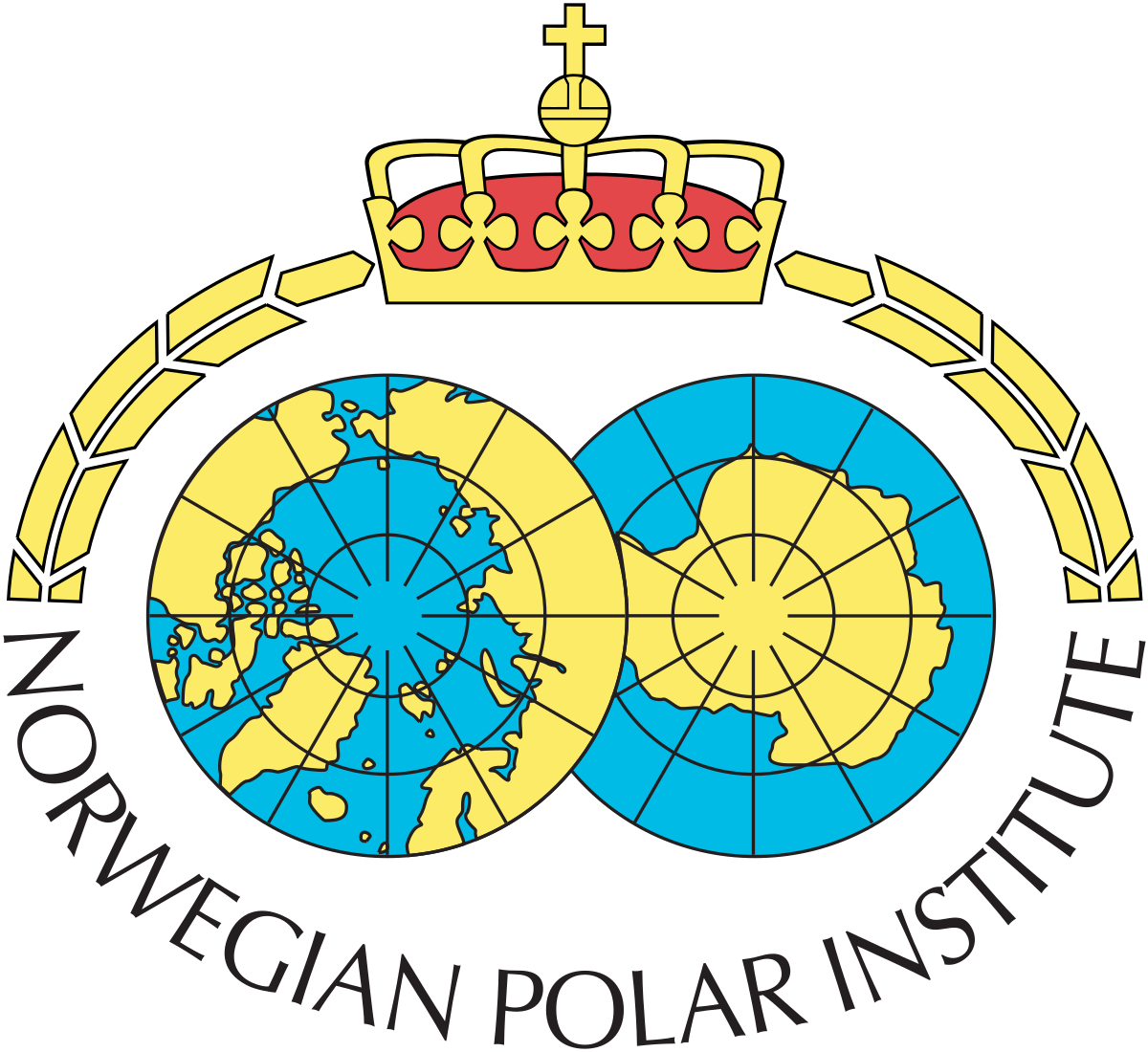-
Prelude: The Past and Present of Polar Science
 The Prelude gives the reader an introduction to polar science and the history of the International Polar Year. It provides important background on six polar research themes: Atmosphere, Ice, Ocean, Land, People and Space. The chapter explains why and how we study them, and what further questions are being asked in these research fields to determine the effects of global climate change. This chapter also provides background information for further use in Chapter 1.
The Prelude gives the reader an introduction to polar science and the history of the International Polar Year. It provides important background on six polar research themes: Atmosphere, Ice, Ocean, Land, People and Space. The chapter explains why and how we study them, and what further questions are being asked in these research fields to determine the effects of global climate change. This chapter also provides background information for further use in Chapter 1.Authors: David J. Carlson and Rhian A. Salmon
Contributors: Bettina Kaiser and Elena Bautista Sparrow
Content:
- Introduction
- The Significance of the International Polar Year in Communicating Polar Science
- Six Themes of Polar Science Today and their Why, What and How
- Atmosphere
- Ice
- Ocean
- Land
- People
- Space
- A personal View: The Wonder of the Polar Regions
-
Chapter 1: Education: Teaching Polar Science in the Classroom
 Chapter 1 contains teaching resources for use in the classroom, lab or during a field trip. An icon indicates whether it is a lab, field or classroom activity. Resources are grouped under the book’s six polar themes. The chapter gives the reader a list of activities under each polar theme to help them find specific resources. Each resource contains background information, a description of the activity, a list of necessary material, estimates of preparation and classroom time, objectives, graphics, and suggestions for extensions. The resources are not laid out for students of a certain age group; teachers and educators can adapt them to particular age levels. Activities include student worksheets and visuals that can also be found on the CD-ROM. The CD-ROM further contains background material on indigenous communities in the circumpolar north and additional web links for each activity.
Chapter 1 contains teaching resources for use in the classroom, lab or during a field trip. An icon indicates whether it is a lab, field or classroom activity. Resources are grouped under the book’s six polar themes. The chapter gives the reader a list of activities under each polar theme to help them find specific resources. Each resource contains background information, a description of the activity, a list of necessary material, estimates of preparation and classroom time, objectives, graphics, and suggestions for extensions. The resources are not laid out for students of a certain age group; teachers and educators can adapt them to particular age levels. Activities include student worksheets and visuals that can also be found on the CD-ROM. The CD-ROM further contains background material on indigenous communities in the circumpolar north and additional web links for each activity. Author: Sandra Zicus
Contributors: Jenny Baeseman, Lucette Barber, Jerry Brown, David J. Carlson, Matteo Cattadori, Jane Dobson, Laurent Dubois, Isabelle Du Four, Karen Edwards, Uta Fritsch, Claudia V. Garcia, Anne Giangiulio, Robin Gislason, Tamsin Gray, Bill Grosser, Turtle Haste, Alain Hubert, Louise Huffman, Andrea Kaiser, Jessica Kotierk, Vanessa Lougheed, Eric Huhs, Isla Myers-Smith, Nancy Nix, Nancy Pearson, Caroline Pellaton, Clémentine Rasquin, Philipp Rastner, Bill Robertson, Torsten Sachs, Rhian A. Salmon, Kristi Skebo, Elizabeth Hodges Snyder, Mieke Sterken, Christian Steuer, Steve Stevenoski, Francesca Taponecco, Josep Marlés Tortosa, Alexandre Trinidade Nieuwendam, Craig Tweedie, Anton Van de Putte, Sandra Vanhove, Agathe Weber and José Xavier
Content:
- Introduction
- Six Themes of Polar Science in the Classroom
- Atmosphere
- Ice
- Ocean
- Land
- People
- Space
- Going Further
-
Chapter 2: Tips and Tricks for Science Presentations
 Chapter 2 lists “do’s and don’ts” of successful public engagement for polar scientists. This unit helps readers to understand how presentations should be planned and structured when going into a classroom or a community. The chapter outlines what to expect from certain age groups, how to present inclusively to all audiences, and what the reader should know when presenting to Inuit communities of Nunavut.
Chapter 2 lists “do’s and don’ts” of successful public engagement for polar scientists. This unit helps readers to understand how presentations should be planned and structured when going into a classroom or a community. The chapter outlines what to expect from certain age groups, how to present inclusively to all audiences, and what the reader should know when presenting to Inuit communities of Nunavut.Authors: Jenny Baeseman, Louise Huffman, Kristen Timm and Janet Warburton
Contributors: Mary Albert, Miriam Hebling Almeida, Patricia Azinhaga, Robert Bindschadler, Paul Dionísio, Robin Frisch-Gleason, Cathleen Geiger, Cheri Hamilton, Turtle Haste, Joanna Hubbard, Martin Jeffries, Shelley MacDonell, Liz Murphy, Maria Manuel Passa, Maggie Prevenas, Samuel P. S. Rastrick, Mélianie Raymond, Rhian A. Salmon, Paul F. Schuster, Filipa Silva, Lucia Simion, Cristina Teixeira, Karl Tolstein, Betty Tummel, José Xavier and Sandra Zicus
Content:
- Introduction
- Paving the Way: Preparing for your Presentation
- Finding your Audience
- Talk to the Organiser of the Event before your Go
- Prepare your Presentation
- Along the Road: Key Aspects of Successful Presentations
- The Hook!
- Engage your Audience
- Use Presentation Software Programs Effectively
- Body Language
- Use Presentation Aides
- A Turning Point: Refining your Presentation for Classroom Visits
- For Younger Students (Ages 5 - 9)
- For Middle Grades (Ages 10 - 14)
- For Upper Grades (Ages 15 and up)
- Maintaining Momentum: Guidelines for Educators who Work with Scientists
- Summary: 'To Go' Principles for Science Presentations
-
Chapter 3: Outreach: Inspiring Ideas and Initiatives from around the World
 Chapter 3 provides the reader with an overview of successful education and outreach initiatives in polar science during IPY. It begins with a list of education and outreach categories, which is followed by a one-page overview of school level, university level, and public level initiatives. The rest of the chapter showcases successful initiatives in these three groups. Each project description lists the country, key aspects, keys to success, and the relevant education and outreach category that they fall into.
Chapter 3 provides the reader with an overview of successful education and outreach initiatives in polar science during IPY. It begins with a list of education and outreach categories, which is followed by a one-page overview of school level, university level, and public level initiatives. The rest of the chapter showcases successful initiatives in these three groups. Each project description lists the country, key aspects, keys to success, and the relevant education and outreach category that they fall into.Author: Lucette Barber
Contributors: Jenny Baeseman, David J. Carlson, Karen Edwards, Bettina Kaiser, Lars Poort, Khadijah Abdul Rahman-Sinclair, Mélianie Raymond, Rhian A. Salmon, Elena Bautista Sparrow, and Tim Straka
Content:
- Introduction: A Rationale for Education and Outreach
- Outreach at a Glance: A List of Outreach Categories
- Outreach in Detail: A Selection of Initiatives from around the World
- School Level Initiatives
- University Level Initiatives
- Public Level Initiatives
-
Chapter 4: IPY and Local Competence Building in the Circumpolar North
 Chapter 4 discusses the role of IPY and the impact of climate change on indigenous communities in the circumpolar north. This essay also explains in detail the significance of Traditional Knowledge for polar research.
Chapter 4 discusses the role of IPY and the impact of climate change on indigenous communities in the circumpolar north. This essay also explains in detail the significance of Traditional Knowledge for polar research.Authors: Ole Herik Magga, Svein D. Mathiesen, Anders Oskal and Johan Mathis Turi
Content:
- Introduction
- The Voice of Reindeer Herding Communities during IPY
- IPY EALÁT: The Significance of IPY for Reindeer Herding Peoples
- Strengthening Traditional Knowledge in Polar Research
- Conclusion: Adaptation to Change and Unpredictability


